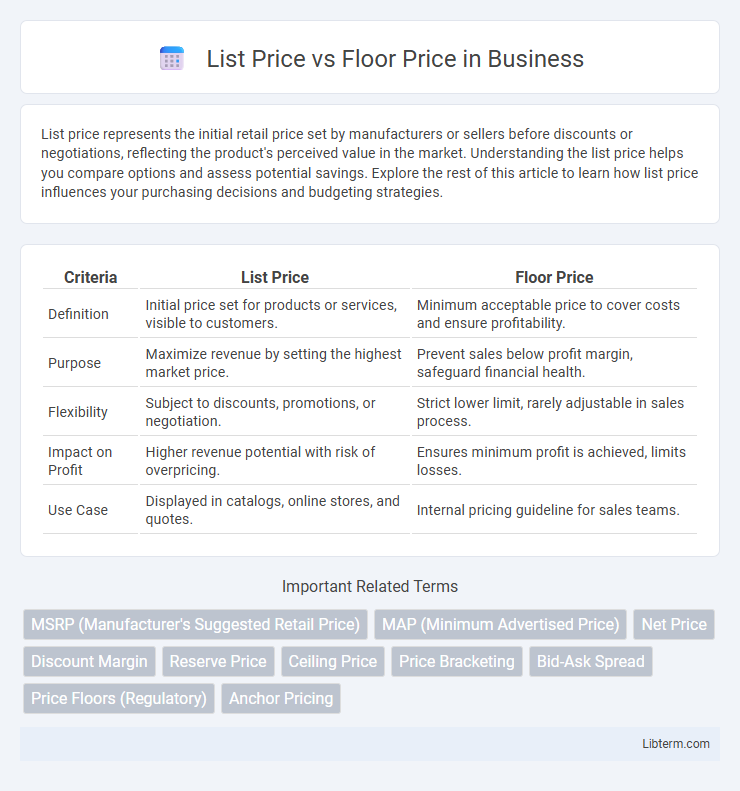List price represents the initial retail price set by manufacturers or sellers before discounts or negotiations, reflecting the product's perceived value in the market. Understanding the list price helps you compare options and assess potential savings. Explore the rest of this article to learn how list price influences your purchasing decisions and budgeting strategies.
Table of Comparison
| Criteria | List Price | Floor Price |
|---|---|---|
| Definition | Initial price set for products or services, visible to customers. | Minimum acceptable price to cover costs and ensure profitability. |
| Purpose | Maximize revenue by setting the highest market price. | Prevent sales below profit margin, safeguard financial health. |
| Flexibility | Subject to discounts, promotions, or negotiation. | Strict lower limit, rarely adjustable in sales process. |
| Impact on Profit | Higher revenue potential with risk of overpricing. | Ensures minimum profit is achieved, limits losses. |
| Use Case | Displayed in catalogs, online stores, and quotes. | Internal pricing guideline for sales teams. |
Understanding List Price: Definition and Purpose
The list price, also known as the manufacturer's suggested retail price (MSRP), represents the initial price set by a seller or manufacturer as a reference for consumers. It serves as a benchmark for discounts, promotions, and negotiations, guiding buyers on the product's value before any price adjustments. Understanding the list price helps consumers evaluate the actual market value and the potential savings when comparing it with the floor price or final selling price.
What is Floor Price? Key Concepts Explained
Floor price represents the minimum acceptable price set by sellers or manufacturers to ensure profitability and market stability, preventing items from being sold below cost. It plays a crucial role in auctions, real estate, and stock markets by setting a baseline that protects the value of goods or assets. Understanding floor price helps buyers and sellers negotiate effectively by establishing the lowest permissible price point in transactions.
Differences Between List Price and Floor Price
List price represents the initial price set by a seller for a product or service, often reflecting market conditions, brand value, and target profit margins. Floor price, by contrast, is the minimum acceptable price determined to cover costs and prevent losses, acting as a lower boundary during negotiations or sales. Understanding the differences between list price and floor price is crucial for pricing strategies, maximizing revenue, and managing competitive positioning.
Importance of List Price in Sales Strategies
The list price serves as a crucial reference point for both buyers and sellers, shaping market perceptions and guiding negotiation dynamics. Establishing an optimal list price influences consumer expectations, drives foot traffic, and enhances competitive positioning within the sales landscape. Accurate list pricing ensures alignment with market demand and maximizes revenue potential by balancing attractiveness with profitability.
Role of Floor Price in Pricing Policies
The floor price sets the minimum allowable selling price, preventing products from being sold below a certain threshold to protect brand value and maintain market stability. In pricing policies, it acts as a safeguard against excessive discounting that could erode profit margins or devalue the product in consumers' perception. By establishing a baseline, the floor price ensures consistency across sales channels and supports sustainable revenue management.
Factors Influencing List Price and Floor Price
List price is influenced by market demand, production costs, competitor pricing, and brand positioning, determining the optimal selling price visible to customers. Floor price is driven primarily by minimum acceptable profit margins, variable costs, and inventory management strategies to prevent losses. Both prices are critical for balancing profitability with competitiveness in dynamic market conditions.
Impact on Buyer and Seller Negotiations
List price sets the initial market expectation, influencing buyer perceptions of value and negotiation strategy, while the floor price establishes the minimum acceptable offer, limiting seller concessions and shaping bargaining boundaries. Buyers often use the list price as a reference to negotiate discounts, affecting their willingness to close a deal, whereas sellers rely on the floor price to protect profit margins and avoid underselling. The interplay between list price and floor price defines the negotiation range, impacting deal velocity and satisfaction for both parties.
Real-World Examples: List Price vs Floor Price
In real estate, list price represents the seller's initial asking price, while the floor price is the minimum amount they are willing to accept. For example, a home listed at $500,000 with a floor price of $450,000 indicates flexibility for negotiations but sets a firm lower limit. Understanding these distinctions helps buyers and sellers navigate market dynamics, such as bidding wars or price reductions in competitive markets like New York City or San Francisco.
Common Misconceptions About Pricing Terms
List Price and Floor Price often cause confusion, as many mistakenly believe the List Price is the actual selling price, when it is usually the manufacturer's suggested retail price (MSRP). The Floor Price represents the lowest acceptable price a seller can offer without incurring a loss, but some assume it to be a fixed or publicly disclosed figure. Misunderstandings arise when buyers expect discounts below the Floor Price or interpret the List Price as the final transaction value, ignoring dealer incentives and market dynamics.
Best Practices for Setting Effective List and Floor Prices
Effective list price setting involves thorough market research and competitive analysis to position products attractively while maximizing revenue potential. Establishing a floor price requires understanding cost structures and minimum acceptable margins to prevent losses and maintain profitability. Combining data-driven pricing strategies with periodic reviews ensures both list and floor prices adapt to market fluctuations and customer demand.
List Price Infographic

 libterm.com
libterm.com